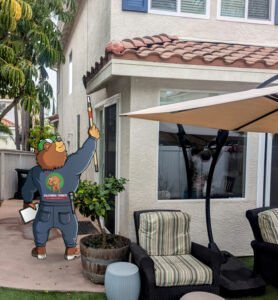License No. PR9657
What to Expect During Your Termite Inspection
 As a homeowner—whether it’s your first home or one you’ve lived in for years—it’s important to know what happens during a termite inspection. Many homeowners have never experienced a thorough termite inspection, and understanding the process can ensure you’re prepared and know what to expect.
As a homeowner—whether it’s your first home or one you’ve lived in for years—it’s important to know what happens during a termite inspection. Many homeowners have never experienced a thorough termite inspection, and understanding the process can ensure you’re prepared and know what to expect.
1. Call Before Going
It’s common courtesy for inspectors to call ahead to confirm the appointment. Surprisingly, this step is often overlooked. A simple reminder call can save time and avoid miscommunication. Some customers forgot they scheduled an inspection. Calling ahead not only respects your time but also allows the inspector to narrow the two-hour time window typically given for inspections, offering better accuracy and convenience.
2. Pre-Inspection Conversation
A conversation with the homeowner before starting the inspection provides invaluable context. For example, if a home has visible termite droppings but was fumigated three years prior. It’s crucial to know that history before making recommendations.
This dialogue helps identify:
- Past fumigations or treatments.
- Sensitivities to chemicals or allergies.
- Signs of swarming termites during specific seasons.
- Previous wood damage and repairs.
- Whether preventative treatments like borate have been applied.
Inspectors who skip this step may prioritize selling treatments over determining what’s truly best for the homeowner.
3. Measuring and Diagramming the Home
This step is essential for creating a legal document that communicates with termite technicians and serves as a reference for future inspections. Accurate measurements are especially critical if fumigation is required—incorrect measurements can lead to ordering the wrong volume of gas, risking treatment failure.
If your inspector seems focused or quiet during this phase, it’s because they’re ensuring precision. Oddly shaped homes can be challenging to diagram, but accurate diagrams are crucial for effective treatment and legal compliance.
4. Probing Your Wood
Inspectors use metal probes to check wood for termite activity, which can surprise inexperienced homeowners. Some may even think the inspector’s probing is damaging their wood. However, this process reveals hidden infestations. Drywood termites often eat wood from the inside out, leaving the surface intact.
At California Termite, we focus on identifying areas requiring treatment without unnecessary damage. Our goal is to keep the wood intact so it can hold the treatment effectively.
5. Marking with Chalk
Chalk marks guide technicians to the exact areas requiring treatment. They act as timestamps in attics, crawl spaces and garages, to document old termite evidence and monitor treatment effectiveness. While some inspectors avoid marking to prevent tipping off competitors, we prioritize transparency and accuracy to ensure the best results.
6. Inspecting Attics, Crawlspaces, and Garages
Thorough inspections include examining attics, crawlspaces, and garages. Attics are the “heart” of the home. They can reveal vital evidence of termite activity. For example, finding termite wings or droppings in the attic may indicate the need for fumigation.
If these areas are inaccessible, it’s better to reschedule the inspection to ensure no critical evidence is missed. A complete inspection often means accessing all rooms of the home—a necessary step to avoid incomplete findings.
7. We Don’t Just Inspect for Termites
At California Termite, we’re not here to up sell you on unnecessary services. However, if we notice something concerning during the inspection, we believe it’s our responsibility to let you know. If we identify conditions that could potentially lead to a termite infestation, we’ll show you exactly what we’re seeing and provide guidance on how to address them effectively. Our goal is to equip you with the knowledge to protect your home, not just treat it.
8. Inspecting Decks
Decks and the eaves above them are common areas for termite activity. The eave wood above a deck is often inaccessible from the exterior. It’s important to access all these areas, even if it requires traveling through a bedroom.
9. Post-Inspection Walk Through
At California Termite, we don’t just tell you about termites—we show you. If evidence is found in hard-to-reach areas like attics, we provide photos for clarity. This walk through ensures transparency and helps homeowners understand the extent and nature of the issue. Sometimes we receive feedback from a customer and the evidence we found may be old. We want to address everything with the homeowner to avoid unnecessary treatments.
10. Explanation of Treatment Options
We explain every treatment option in detail, including what will work, what won’t, and why. Whether localized treatments or fumigation are needed, we provide a clear overview so you know what to expect.
11. Pricing
Before leaving, we provide a straightforward price quote with no expiration date, daily deals, or high-pressure tactics. At California Termite, our goal is not to “sell” you—it’s to help you. We encourage you to take your time and make an informed decision.
12. Subsequent Termite Report
A detailed termite report will be emailed to you within a few days. This report includes findings, treatment recommendations, and a record for future reference.
By understanding these steps, you can feel confident during your termite inspection. At California Termite, we pride ourselves on transparency, thoroughness, and putting the homeowner’s best interests first. If you have any questions or concerns, don’t hesitate to ask your inspector during the process.


